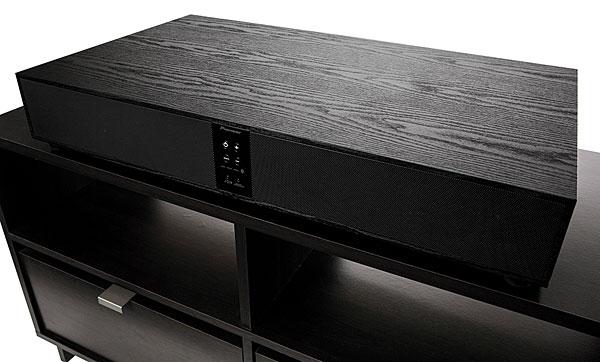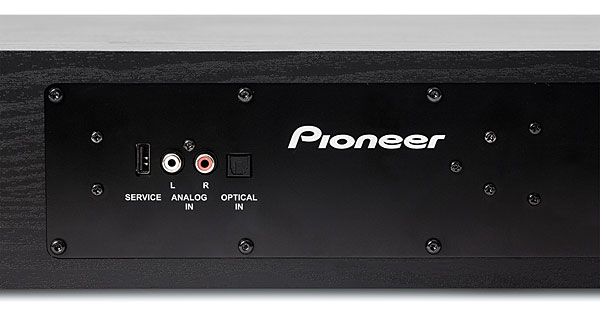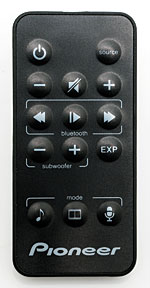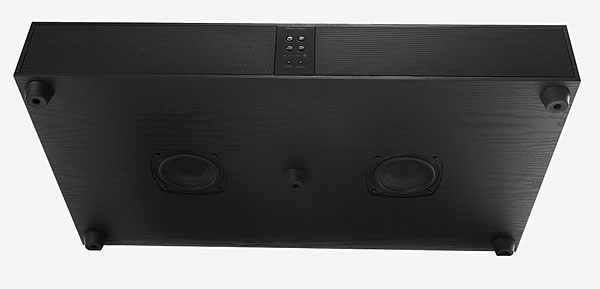Pioneer SP-SB03 Speaker Base

AT A GLANCE
Plus
Clear, transparent sound
Well-thought-out feature set
Minus
Minimal display information
Credit-card membrane remote
THE VERDICT
Pioneer delivers a soundbase that puts good sound ahead of bells and whistles or sheer volume.
Over the last few years, Pioneer’s chief speaker designer Andrew Jones has become kind of a rock star in budget audio circles. Unlike some other companies that simply get a design committee to slap something together for their low-cost gear, Pioneer with Jones at the helm spends months tweaking and refining even the most modest speakers. At the other end of the scale, Jones also designs state-of-the-art speakers for Pioneer’s high-end TAD division, including the $80,000 Reference One, so the man clearly knows his way around a woofer cone.
Here Jones has turned his talents toward creating the SP-SB03, Pioneer’s first TV soundbase. The basic feature set is pretty similar to the company’s SP-SB23W soundbar, but it moves that model’s separate subwoofer into the main speaker to create a single-box solution. The SP-SB03 is essentially a pair of three-way powered speakers in one cabinet and is the only soundbase of the three we looked at that uses separate dedicated tweeters to handle the high frequencies. Each of the six drivers also gets its own amplifier fed by an active low-level crossover, an approach normally seen in expensive professional speakers.

The purposeful-looking SP-SB03 has a composite wood cabinet with a perforated metal grille on the front to protect the drivers. Pioneer sets a weight limit of 150 pounds for the TV you can put on it and states that the stand should fit on the base with at least 1 extra inch all around. A fifth foot at the center of the base provides plenty of support for heavy TVs.
 Input options are pretty basic, with just one stereo RCA analog input, one optical digital input, and Bluetooth. The USB jack tucked away on the back panel is strictly for service use. As with the Vizio, the SP-SB03 directly decodes Dolby Digital and PCM digital signals, but not DTS, so you may have to set your player accordingly. The lack of a second digital input may also be an issue in some installations where you’re not using the TV as your switching component.
Input options are pretty basic, with just one stereo RCA analog input, one optical digital input, and Bluetooth. The USB jack tucked away on the back panel is strictly for service use. As with the Vizio, the SP-SB03 directly decodes Dolby Digital and PCM digital signals, but not DTS, so you may have to set your player accordingly. The lack of a second digital input may also be an issue in some installations where you’re not using the TV as your switching component.
The SP-SB03’s remote is a small credit-card-style job with those nasty blister bump buttons, though Pioneer likely assumes you’ll use the unit’s learning mode to train it to respond to commands from your existing cable box, TV, or universal remote. Instead of traditional bass and treble controls, you get a level control for the bass drivers and three preset equalization curves called Music, Movies, and Dialog. There’s also a simulated surround circuit called Expansion, available only in the Movie mode.
Input and listening mode selections are indicated on the front panel by colored LED indicators. It’s hard to read the tiny labels from across a room, but you’ll quickly learn that a green light indicates Movie mode, while red is for Music mode. The Dialog mode (blue) is for late-night listening when you don’t want to disturb people; it appeared to simply turn the woofers way down.
With a total of 168 watts split between the six drivers, the SP-SB03 does a pretty good job of rattling the windows with big action movies. It can’t quite turn your living room into Studio 54 the way the Vizio can, but the priority here is clearly on quality over sheer quantity of sound.

The helicopter crash and lodge explosion scene in Skyfall maxed out a couple of decibels lower in volume than with the Vizio, but it was still substantially louder than I would normally play movies at home. More important, there was a greater sense of clarity and coherence that made listening to the Pioneer the least fatiguing and most enjoyable of the three soundbases. Dialogue was clear and articulate, without any boxy colorations.
In the Movie mode, the Pioneer pumped up the bass a bit from neutral. This worked quite well for big action scenes, although I found I still generally preferred the balance of the Music mode even with movies. The Expansion option did a pretty decent job of opening out the sound from the box, so it’s a pity it was only available in Movie mode.
As you might expect given its designer, the SP-SB03 excelled with music. Sure, you’re never going to get much of a stereo soundstage when the left and right speakers are just a couple of feet apart, but the Pioneer’s ability to deliver transparent and natural-sounding music with excellent tonality won me over. On the Charles Lloyd track Rabo De Nube, there was real weight and definition behind the double bass line, and drummer Billy Hart’s cymbals had a clarity and vibrancy of tonal color that the other soundbases couldn’t match.



























































